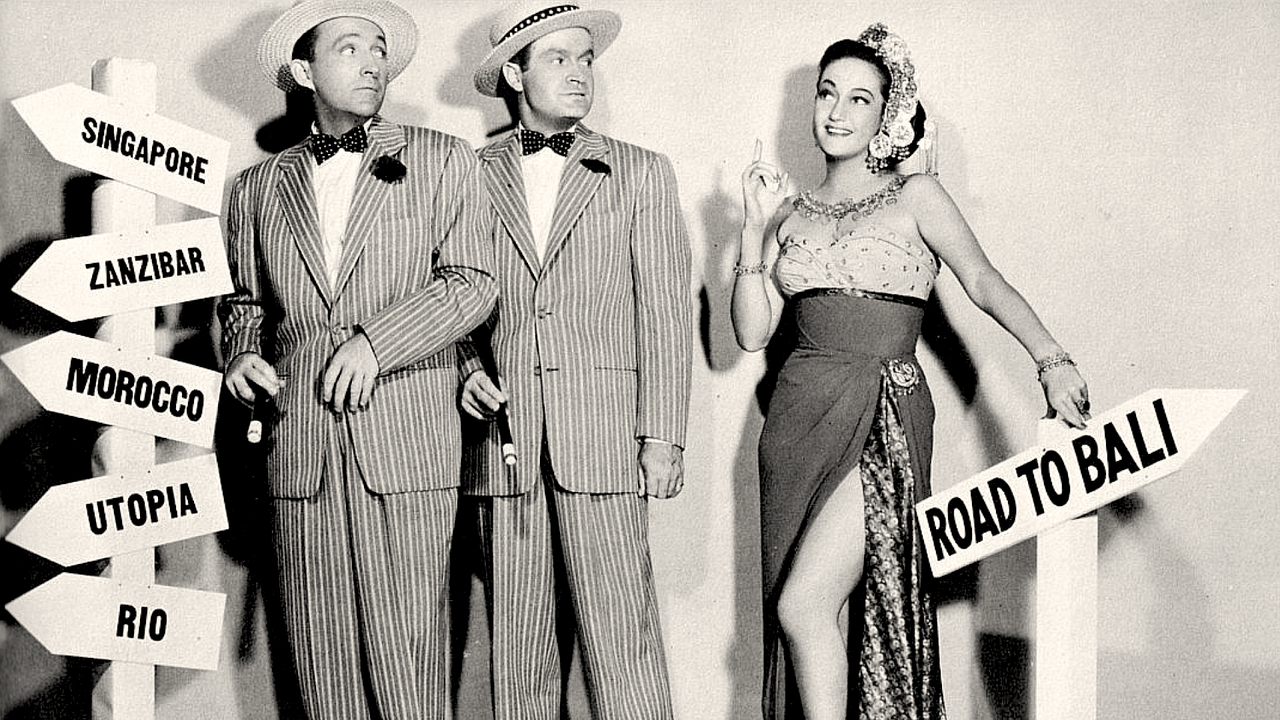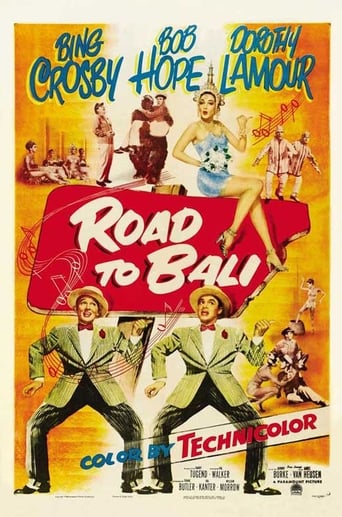

The 'Road' movies are the kind of films that used to be programmed on British TV in the late '70s/early '80s on a (usually rainy) Sunday afternoon, when there was little else to do except play board games. I watched them when I was young and remember finding them relatively amusing at the time—well, more fun than a game of Mousetrap (all that setting up the plastic pieces for it not to work!).Having just watched Road To Bali, my first Road trip since I was a kid, I'm wondering what the hell I was thinking: the film is a horribly antiquated comedy with gags well past their sell-by-date and dull song and dance routines. The plot is all over the place, but mainly consists of our two happy-go-lucky heroes, George Cochran (Bing Crosby) and Harold Gridley (Bob Hope) arguing about who is going to marry beautiful Princess Lala (Dorothy Lamour), who they meet after applying for jobs as deep sea divers, their mission to retrieve a long sunken treasure guarded by a massive squid.The vaudevillian jokes (scripted and ad-libbed), many of which were topical at the time, come thick and fast, but unless you're an octogenarian (and still blessed with your hearing and your marbles), I doubt very much if you'll find very many of them funny because you simply won't 'get' them (I'm fast approaching fifty and many of the quips sailed way over my head). Fortunately, the presence of the gorgeous Dorothy Lamour helps matters a lot, and there are a couple of fun, silly moments featuring the giant squid and an amorous gorilla, but with such dreadful gags and unmemorable songs, the hour and a half really felt like a lot longer.***According to other comments here on IMDb, 'Bali' is one of the weaker Road movies. If I ever decide to take another trip down memory lane with Bing and Bob, I sure hope they're right.***
... View MoreTrying to avoid shotgun weddings, two entertainers (Bob Hope, Bing Crosby) run away and take jobs as deep sea divers. This leads them to Bali and princess Dorothy Lamour. Inevitably both guys vie for Dorothy's affections while tangling with bad guys and a giant squid.Routine 'Road' picture with the notable difference of it being in color. Hope and Crosby are always fun, especially when they break the fourth wall. Lamour is lovely in color. This was her last film for ten years. Some of the gags are tired but there are still lots of yuks. Also some decent songs. Overall the likable personalities of the trio keep it afloat. Jane Russell, Martin & Lewis, and Humphrey Bogart (through African Queen footage) all have cameos. There is one rather odd sequence where Dorothy dreams of her childhood pet monkey and we see a real chimp wearing a very creepy Bob Hope mask.
... View MoreThis comedy is the sixth of the seven 'road to' series and is the only one to be filmed in color. When you have a good formula keep it working. Bob Hope plays Harold and Bing Crosby plays George, two out of work song-and-dance men, who have to leave Australia in a hurry to avoid a couple of marriage proposals. The two are hired as deep-sea divers by a South Seas prince(Murvyn Vye)in order to recover a buried treasure. Of course, there has to be a beautiful princess...Dorothy Lamour plays Princess Lala; and Harold and George go 'ga-ga' for the beauty as the three head to Bali to sell the recovered treasure chest full of jewels. Cannibals, alligators and a giant squid vie for screen time; as well as cameos by Jerry Lewis, Dean Martin and Bing's brother Bob. There are several songs with the best being "Moonflowers" by Lamour and "To See You Is To Love You" by Crosby. Others in the cast: Michael Ansara, Ralph Moody, Peter Coe and Carolyn Jones.
... View MoreBy this time - the sixth in an eventual series of seven - the formula was well established; wise-cracks, in-jokes, forget the 'fourth wall', throw in some 'cameos' (in this case Bogie, Jane Russell, Bob Crosby and Martin and Lewis), a 'plot' that sees Bing con Bob into taking some dangerous job (human canon ball, deep-sea diver, etc), a soupcon of song and dance and away we go. This time around the duo leave town one bullet in front of a shotgun wedding - actually two bullets and two shotgun weddings as both Bing and Bob have dallied with local girls in Australia. They were, by definition, of their time so that much of the humour may seem flat but what remains is the great 'timing' and rapport between Hope and Crosby and perhaps above all the songs, many of which became not only 'hits' of the day but went on to become 'standards' such as Moonlight Becomes You and But Beautiful. This is hardly surprising given that Johnny Burke wrote the lyrics for the first six and Jimmy Van Heusen the music for the last six (Burke worked with composer James V. Monaco - 'Too Romantic' on the first in the series, Singapore and Van Heusen worked with new partner Sammy Cahn on the seventh, Hong Kong). The score here is as fine as ever with such gems as Chicago Style, To See You Is To Love You, Hoots, Mon, and Moonflower. Maybe not the best of the seven but not the worst either and the only one in colour.
... View More